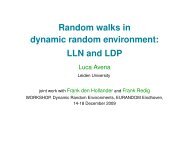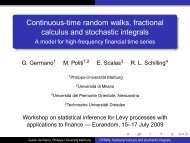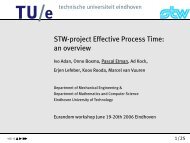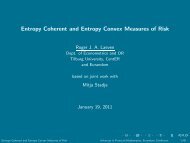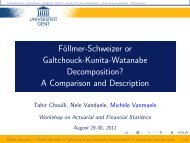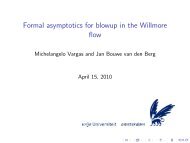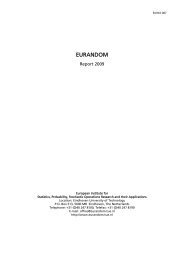Busse balloons - from the reversible Gray-Scott model ... - Eurandom
Busse balloons - from the reversible Gray-Scott model ... - Eurandom
Busse balloons - from the reversible Gray-Scott model ... - Eurandom
You also want an ePaper? Increase the reach of your titles
YUMPU automatically turns print PDFs into web optimized ePapers that Google loves.
Introduction<br />
Rise of Patterns<br />
The <strong>Busse</strong> balloon<br />
Conclusions and ongoing research<br />
<strong>Busse</strong> <strong>balloons</strong><br />
<strong>from</strong> <strong>the</strong> <strong>reversible</strong> <strong>Gray</strong>-<strong>Scott</strong> <strong>model</strong> to non<strong>reversible</strong><br />
Klausmeier <strong>model</strong>s with nonlinear diffusion<br />
Sjors van der Stelt<br />
University of Amsterdam<br />
April 14, 2010<br />
in cooperation with<br />
Arjen Doelman and Jens D.M. Rademacher<br />
Sjors van der Stelt <strong>Busse</strong> <strong>balloons</strong>
Introduction<br />
Rise of Patterns<br />
The <strong>Busse</strong> balloon<br />
Conclusions and ongoing research<br />
Direct motivation: vegetation patterns. Below in Sahel<br />
Figure: Spotted patterns<br />
Sjors van der Stelt <strong>Busse</strong> <strong>balloons</strong>
The Model<br />
Introduction<br />
Rise of Patterns<br />
The <strong>Busse</strong> balloon<br />
Conclusions and ongoing research<br />
◮ We <strong>model</strong> <strong>the</strong>se patterns by<br />
Ut = DU γ xx + A(1 − U) − UV 2 + CUx<br />
Vt = δ 2 Vxx − BV + UV 2 .<br />
(γ depending on <strong>the</strong> kind of soil, C = 0 on flat terrain)<br />
Sjors van der Stelt <strong>Busse</strong> <strong>balloons</strong>
The Model<br />
Introduction<br />
Rise of Patterns<br />
The <strong>Busse</strong> balloon<br />
Conclusions and ongoing research<br />
◮ We <strong>model</strong> <strong>the</strong>se patterns by<br />
Ut = DU γ xx + A(1 − U) − UV 2 + CUx<br />
Vt = δ 2 Vxx − BV + UV 2 .<br />
(γ depending on <strong>the</strong> kind of soil, C = 0 on flat terrain)<br />
◮ This is a generalization of <strong>the</strong> system introduced by <strong>the</strong> ecologist C.<br />
Klausmeier (’99) (D=0, parameters in Klausmeier’s original scaling)<br />
Ut = Ux + n − U − UV 2<br />
Vt = δ 2 Vxx − mV + UV 2 ;<br />
Sjors van der Stelt <strong>Busse</strong> <strong>balloons</strong>
The Model<br />
Introduction<br />
Rise of Patterns<br />
The <strong>Busse</strong> balloon<br />
Conclusions and ongoing research<br />
◮ We <strong>model</strong> <strong>the</strong>se patterns by<br />
Ut = DU γ xx + A(1 − U) − UV 2 + CUx<br />
Vt = δ 2 Vxx − BV + UV 2 .<br />
(γ depending on <strong>the</strong> kind of soil, C = 0 on flat terrain)<br />
◮ This is a generalization of <strong>the</strong> system introduced by <strong>the</strong> ecologist C.<br />
Klausmeier (’99) (D=0, parameters in Klausmeier’s original scaling)<br />
Ut = Ux + n − U − UV 2<br />
Vt = δ 2 Vxx − mV + UV 2 ;<br />
◮ It also generalises <strong>the</strong> <strong>Gray</strong>-<strong>Scott</strong> system (C = 0, D = 1, γ = 1)<br />
Ut = Uxx + A(1 − U) − UV 2<br />
Vt = δ 2 Vxx − BV + UV 2 .<br />
Sjors van der Stelt <strong>Busse</strong> <strong>balloons</strong>
Birth of patterns<br />
Introduction<br />
Rise of Patterns<br />
The <strong>Busse</strong> balloon<br />
Conclusions and ongoing research<br />
◮ We consider A as <strong>the</strong> critical parameter. A corresponds to <strong>the</strong><br />
rainfall.<br />
Sjors van der Stelt <strong>Busse</strong> <strong>balloons</strong>
Birth of patterns<br />
Introduction<br />
Rise of Patterns<br />
The <strong>Busse</strong> balloon<br />
Conclusions and ongoing research<br />
◮ We consider A as <strong>the</strong> critical parameter. A corresponds to <strong>the</strong><br />
rainfall.<br />
◮ For A below some critical value Ac, <strong>the</strong> (stable) homogeneous<br />
background state looses its stability with respect to periodic<br />
perturbations. This is called a Turing-Hopf bifurcation.<br />
Sjors van der Stelt <strong>Busse</strong> <strong>balloons</strong>
Introduction<br />
Rise of Patterns<br />
The <strong>Busse</strong> balloon<br />
Conclusions and ongoing research<br />
The Eckhaus band: symmetric (<strong>Gray</strong>-<strong>Scott</strong>) case<br />
Let A be <strong>the</strong> amplitude of <strong>the</strong> emerging pattern. Then <strong>the</strong> pattern can<br />
be written out as<br />
U ∝ U0 + εA(ξ, τ)e ikc x + c.c. + h.o.t.<br />
In <strong>the</strong> case of <strong>the</strong> <strong>Gray</strong>-<strong>Scott</strong> system, e.g., we find for A a real GLE:<br />
Aτ = 2<br />
√ b A + 2 √ 2Aξξ − 2<br />
9 (10√ 2 − 7)|A| 2 A<br />
A band of spatially periodic patterns bifurcates for<br />
k ∈ (kc − ε √ r, kc + ε √ r)<br />
Stable patterns only exist in <strong>the</strong> Eckhaus band<br />
<br />
r<br />
k ∈ (kc − ε<br />
3 , kc<br />
<br />
r<br />
+ ε<br />
3 )<br />
Sjors van der Stelt <strong>Busse</strong> <strong>balloons</strong>
Introduction<br />
Rise of Patterns<br />
The <strong>Busse</strong> balloon<br />
Conclusions and ongoing research<br />
Let k be <strong>the</strong> wavenumber of a pattern born at <strong>the</strong> Turing bifurcation.<br />
For |A − Ac| = O(ε), <strong>the</strong> Eckhaus band describes a region in (A, k)-space<br />
where stable patterns exist.<br />
A<br />
Eckhaus band<br />
Existence band<br />
k<br />
Figure: The Eckhaus band.<br />
Sjors van der Stelt <strong>Busse</strong> <strong>balloons</strong><br />
A=A Turing
Introduction<br />
Rise of Patterns<br />
The <strong>Busse</strong> balloon<br />
Conclusions and ongoing research<br />
The Eckhaus band: nonsymmetric case (C > 0)<br />
Let A be <strong>the</strong> amplitude of <strong>the</strong> emerging pattern. The evolution of A is<br />
now described by <strong>the</strong> Complex GLE :<br />
Aτ = (α1 + iα2)Aξξ + (β1 + iβ2)A + (γ1 + iγ2)|A| 2 A.<br />
Spatially periodic patterns appear at a Turing-Hopf bifurcation and are<br />
now travelling:<br />
i(kc x+ωc t)<br />
A(ξ, τ) = Re<br />
The Turing-Hopf bifurcation is subcritical if <strong>the</strong> so-called Landau<br />
coefficient satisfies<br />
1 + α2γ2<br />
α1γ2<br />
> 0.<br />
Sjors van der Stelt <strong>Busse</strong> <strong>balloons</strong>
Introduction<br />
Rise of Patterns<br />
The <strong>Busse</strong> balloon<br />
Conclusions and ongoing research<br />
Super- vs. subcritical bifurcation<br />
k<br />
A<br />
Figure: Schematic picture of supercritical bifurcation (left) and<br />
subcritical bifurcation (right).<br />
Sjors van der Stelt <strong>Busse</strong> <strong>balloons</strong><br />
k<br />
A
Introduction<br />
Rise of Patterns<br />
The <strong>Busse</strong> balloon<br />
Conclusions and ongoing research<br />
Results: calculation of Landau-coefficient<br />
16<br />
14<br />
12<br />
10<br />
8<br />
6<br />
4<br />
2<br />
0<br />
1<br />
1<br />
1<br />
0<br />
3<br />
4<br />
1<br />
1<br />
2<br />
4<br />
0<br />
3<br />
2 4 6 8 10 12 14 16<br />
2<br />
0<br />
20<br />
40<br />
60<br />
80<br />
2 4 6 8 10 12 14 16<br />
Figure: plots of b against C, for γ = 1 (supercritical) and γ = 2<br />
(subcritical for some values of b if C > 0)<br />
Sjors van der Stelt <strong>Busse</strong> <strong>balloons</strong><br />
16<br />
14<br />
12<br />
10<br />
8<br />
6<br />
4<br />
2<br />
0
<strong>Busse</strong> balloon<br />
Introduction<br />
Rise of Patterns<br />
The <strong>Busse</strong> balloon<br />
Conclusions and ongoing research<br />
◮ The Eckhaus band is only <strong>the</strong> beginning! The complete region of<br />
stable patterns in (A, k)-space is called <strong>the</strong> <strong>Busse</strong> balloon.<br />
Sjors van der Stelt <strong>Busse</strong> <strong>balloons</strong>
<strong>Busse</strong> balloon<br />
Introduction<br />
Rise of Patterns<br />
The <strong>Busse</strong> balloon<br />
Conclusions and ongoing research<br />
◮ The Eckhaus band is only <strong>the</strong> beginning! The complete region of<br />
stable patterns in (A, k)-space is called <strong>the</strong> <strong>Busse</strong> balloon.<br />
◮ No ma<strong>the</strong>matical analysis possible! → but numerics! Continuation<br />
and bifurcation software (Auto)<br />
Sjors van der Stelt <strong>Busse</strong> <strong>balloons</strong>
Introduction<br />
Rise of Patterns<br />
The <strong>Busse</strong> balloon<br />
Conclusions and ongoing research<br />
Example: <strong>Busse</strong> balloon for <strong>Gray</strong>-<strong>Scott</strong> system<br />
k<br />
17.5<br />
15.0<br />
12.5<br />
10.0<br />
7.5<br />
5.0<br />
2.5<br />
sn 1<br />
Hopf +1<br />
sideband<br />
0.0<br />
0.000 0.010 0.020 0.030 0.040 0.050<br />
0.00 0.25 0.50 0.75 1.00 1.25 1.50 1.75 2.00<br />
sn<br />
2<br />
equilibrium<br />
A<br />
<strong>Busse</strong> balloon<br />
sideband<br />
2.00<br />
1.75<br />
1.50<br />
1.25<br />
1.00<br />
0.75<br />
0.50<br />
0.25<br />
0.00<br />
equilibrium<br />
sideband<br />
sn<br />
1<br />
Hopf+1<br />
Hopf−1<br />
Figure: A <strong>Busse</strong> balloon for <strong>the</strong> <strong>Gray</strong>-<strong>Scott</strong> <strong>model</strong> with b = ... and γ = 1.<br />
Sjors van der Stelt <strong>Busse</strong> <strong>balloons</strong>
The ‘Hopf dance’<br />
k<br />
Introduction<br />
Rise of Patterns<br />
The <strong>Busse</strong> balloon<br />
Conclusions and ongoing research<br />
Fold<br />
−1<br />
+1<br />
<strong>Busse</strong> balloon<br />
A<br />
(a) (b)<br />
Figure: (a) The Hopf-dance enlarged, schematically. (b) Oscillations in or<br />
out of phase (i.e. for γ = 0 or γ = 1).<br />
Sjors van der Stelt <strong>Busse</strong> <strong>balloons</strong>
Introduction<br />
Rise of Patterns<br />
The <strong>Busse</strong> balloon<br />
Conclusions and ongoing research<br />
Spectrum of solution at Hopf instability<br />
O<br />
Im<br />
Re<br />
Figure: Spectrum for a solution that undergoes a Hopf instability. Left<br />
<strong>the</strong> case for <strong>reversible</strong> systems (like <strong>Gray</strong>-<strong>Scott</strong>), right <strong>the</strong> case for<br />
non<strong>reversible</strong> systems.<br />
Sjors van der Stelt <strong>Busse</strong> <strong>balloons</strong><br />
O<br />
Im<br />
Re
Introduction<br />
Rise of Patterns<br />
The <strong>Busse</strong> balloon<br />
Conclusions and ongoing research<br />
Spectrum of solution at sideband instability<br />
Im<br />
O Re<br />
(a) (b)<br />
Im<br />
O Re<br />
Figure: Spectrum for a solution that undergoes a sideband instability.<br />
Sjors van der Stelt <strong>Busse</strong> <strong>balloons</strong>
Introduction<br />
Rise of Patterns<br />
The <strong>Busse</strong> balloon<br />
Conclusions and ongoing research<br />
<strong>Busse</strong> balloon for C > 0<br />
12<br />
10<br />
8<br />
6<br />
4<br />
2<br />
’b.sideband-C=0.4-B=0.2’ u 9:(2*3.1415926535/$5)<br />
0<br />
0 0.2 0.4 0.6 0.8 1 1.2 1.4<br />
Figure: (Nonedited version of <strong>the</strong>) <strong>Busse</strong> balloon for C = 0.4, B = 0.2,<br />
γ = 1.<br />
Sjors van der Stelt <strong>Busse</strong> <strong>balloons</strong>
Introduction<br />
Rise of Patterns<br />
The <strong>Busse</strong> balloon<br />
Conclusions and ongoing research<br />
Disappearing Hopf dance with increasing C<br />
Figure: Schematic picture showing <strong>the</strong> Hopf instabilities with<br />
γ-eigenvalues for γ = 0 and γ = π and <strong>the</strong> sideband instability in <strong>the</strong><br />
neighbourhood of <strong>the</strong> origin, for C = 0.0 (left), C = 0.2 (middle) and<br />
C = 0.4 (right).<br />
Sjors van der Stelt <strong>Busse</strong> <strong>balloons</strong>
Conclusions<br />
Introduction<br />
Rise of Patterns<br />
The <strong>Busse</strong> balloon<br />
Conclusions and ongoing research<br />
◮ for γ = 2 and C > 0 <strong>the</strong>re are choices for B such that <strong>the</strong><br />
Turing-Hopf bifurcation becomes subcritical (stable patterns and<br />
stable background state)<br />
Sjors van der Stelt <strong>Busse</strong> <strong>balloons</strong>
Conclusions<br />
Introduction<br />
Rise of Patterns<br />
The <strong>Busse</strong> balloon<br />
Conclusions and ongoing research<br />
◮ for γ = 2 and C > 0 <strong>the</strong>re are choices for B such that <strong>the</strong><br />
Turing-Hopf bifurcation becomes subcritical (stable patterns and<br />
stable background state)<br />
◮ for γ = 1 and C = 0 (<strong>Gray</strong>-<strong>Scott</strong>) <strong>the</strong> boundary of <strong>the</strong> full <strong>Busse</strong><br />
balloon consists of a complex interplay of different instabilities<br />
(Hopf, sideband, fold...)<br />
Sjors van der Stelt <strong>Busse</strong> <strong>balloons</strong>
Conclusions<br />
Introduction<br />
Rise of Patterns<br />
The <strong>Busse</strong> balloon<br />
Conclusions and ongoing research<br />
◮ for γ = 2 and C > 0 <strong>the</strong>re are choices for B such that <strong>the</strong><br />
Turing-Hopf bifurcation becomes subcritical (stable patterns and<br />
stable background state)<br />
◮ for γ = 1 and C = 0 (<strong>Gray</strong>-<strong>Scott</strong>) <strong>the</strong> boundary of <strong>the</strong> full <strong>Busse</strong><br />
balloon consists of a complex interplay of different instabilities<br />
(Hopf, sideband, fold...)<br />
◮ for C > 0 (and γ = 1), <strong>the</strong> Hopf dance moves out of <strong>the</strong> stable<br />
<strong>Busse</strong> region<br />
Sjors van der Stelt <strong>Busse</strong> <strong>balloons</strong>
Ongoing research<br />
Introduction<br />
Rise of Patterns<br />
The <strong>Busse</strong> balloon<br />
Conclusions and ongoing research<br />
◮ what exactly happens at <strong>the</strong> right side of <strong>the</strong> <strong>Busse</strong> balloon?<br />
Possible new Hopf instabilies .....<br />
Sjors van der Stelt <strong>Busse</strong> <strong>balloons</strong>
Ongoing research<br />
Introduction<br />
Rise of Patterns<br />
The <strong>Busse</strong> balloon<br />
Conclusions and ongoing research<br />
◮ what exactly happens at <strong>the</strong> right side of <strong>the</strong> <strong>Busse</strong> balloon?<br />
Possible new Hopf instabilies .....<br />
◮ how does <strong>the</strong> <strong>Busse</strong> balloon look like for γ = 2?<br />
Sjors van der Stelt <strong>Busse</strong> <strong>balloons</strong>
Ongoing research<br />
Introduction<br />
Rise of Patterns<br />
The <strong>Busse</strong> balloon<br />
Conclusions and ongoing research<br />
◮ what exactly happens at <strong>the</strong> right side of <strong>the</strong> <strong>Busse</strong> balloon?<br />
Possible new Hopf instabilies .....<br />
◮ how does <strong>the</strong> <strong>Busse</strong> balloon look like for γ = 2?<br />
Sjors van der Stelt <strong>Busse</strong> <strong>balloons</strong>


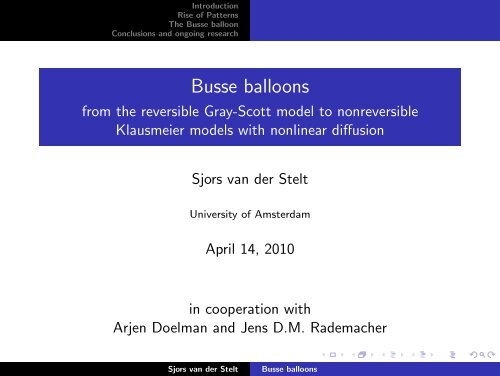
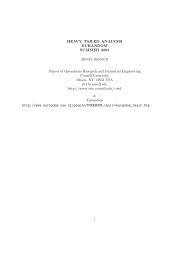
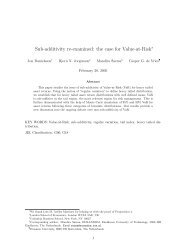
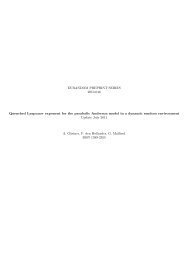
![The Contraction Method on C([0,1]) and Donsker's ... - Eurandom](https://img.yumpu.com/19554492/1/190x143/the-contraction-method-on-c01-and-donskers-eurandom.jpg?quality=85)
